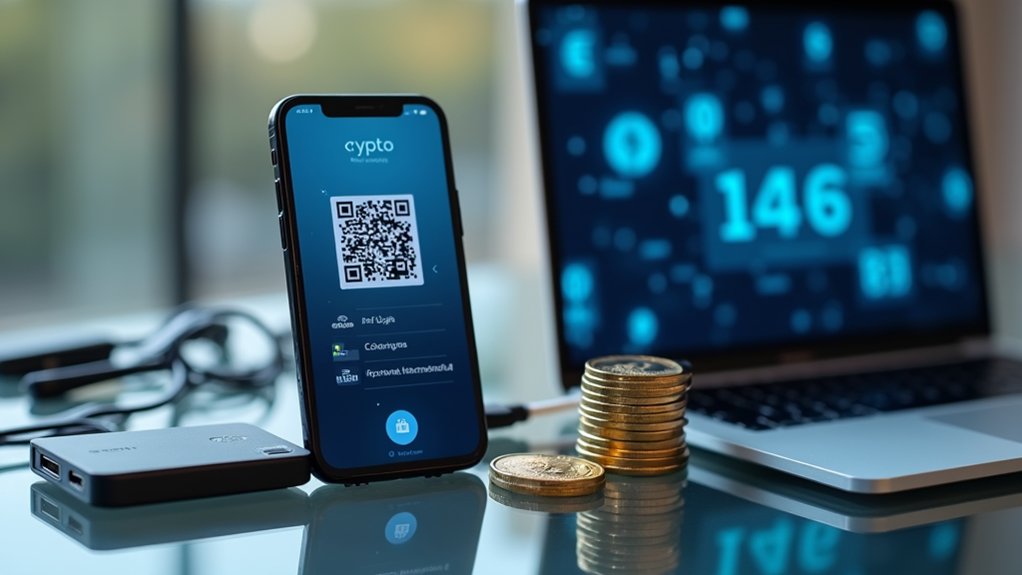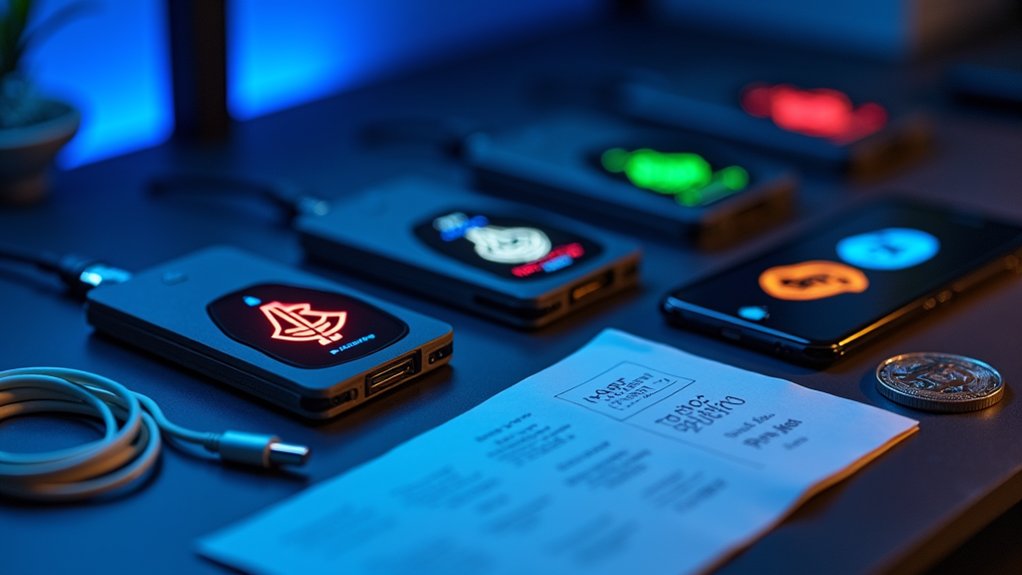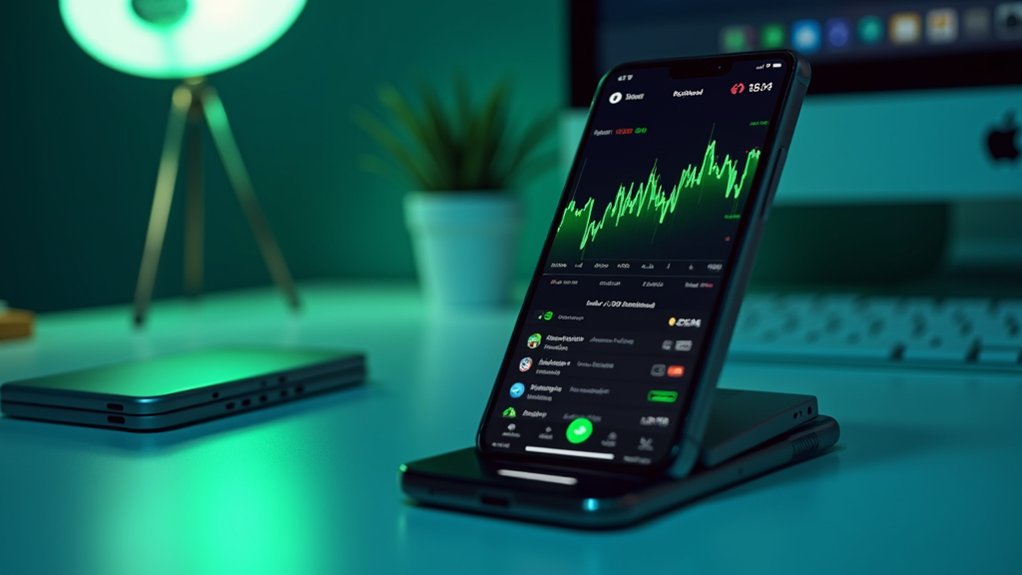Paying with cryptocurrency requires establishing appropriate infrastructure through either exchange-hosted solutions or self-custody wallets. Users must fund accounts via traditional banking methods, complete verification procedures, and understand network fee structures before executing transactions. Payments occur through direct exchange accounts or self-custody wallets involving extensions, mobile apps, or QR code scanning, with technology selecting cost-efficient networks to minimize fees. Critical considerations include double-checking addresses before confirmation and verifying provider status, since cryptocurrency payment systems continue evolving within traditional commerce frameworks.

Many consumers, previously hesitant to embrace digital currencies, now find themselves charting the evolving landscape of cryptocurrency payments, which has transformed from a niche curiosity into a legitimate transaction method across numerous platforms.
The process begins with establishing the necessary infrastructure through either exchange-hosted solutions, like Coinbase.com, or self-custody wallets that offer users complete control over their digital assets. These preparatory steps require users to deposit funds via traditional banking methods, including bank transfers or card payments, or alternatively, transfer existing cryptocurrencies from other holdings into their selected wallet system.
Setting up crypto payments means choosing between exchange platforms or self-custody wallets, then funding through banking transfers or existing digital assets.
Prior to initiating transactions, users must complete verification procedures to guarantee compliance with Know Your Customer (KYC) regulations, a standard practice in financial services designed to prevent fraud and illicit activities. Understanding the network fee structure, commonly referred to as gas costs, represents another vital aspect of the preparation phase, since these fees vary considerably depending on blockchain congestion and transaction complexity.
When executing payments, consumers typically encounter two primary methods: direct payments through exchange accounts or transactions via self-custody wallets. The former involves selecting the "Pay with Coinbase account" option, authenticating access, choosing the desired cryptocurrency, and confirming the transaction. Users should be aware that insufficient funds will prevent them from selecting the "Continue" button to complete their payment.
The latter requires connecting through wallet extensions, dedicated mobile applications, or QR code scanning via protocols like Web3 or WalletConnect, enabling secure authorization of payment transfers. Always double-check addresses before confirming any transaction to ensure funds reach the intended recipient.
The foundational technology automatically selects the most cost-efficient network for completing transactions, with platforms like Base or Polygon often utilized for their lower fee structures compared to mainnet alternatives.
Currency conversion occurs seamlessly during transactions, with merchant settlements typically processed in stablecoins like USDC to mitigate volatility concerns intrinsic to cryptocurrency markets.
It bears noting that Bitcoin payments currently face certain limitations, with only exchange-hosted balances generally supported for direct merchant transactions, reflecting the evolving infrastructure of cryptocurrency payment systems as they continue to mature and integrate with traditional commerce frameworks. Users should be mindful that some platforms may be undergoing operational closures, similar to CryptoWallet.com, making it crucial to verify a provider's status before establishing payment relationships.
Frequently Asked Questions
Is Crypto Payment Legally Recognized in All Countries?
Cryptocurrency payment recognition varies considerably across global jurisdictions, with only a limited number of nations, including El Salvador, Japan, and Malta, offering full legal recognition.
Many countries impose operational restrictions, prohibiting cryptocurrencies as payment methods while allowing trading as assets or commodities.
Regulatory frameworks remain in developmental stages across numerous jurisdictions, including the European Union's forthcoming MiCA regulation, while others maintain ambiguous positions, creating a complex international landscape for crypto payment adoption and acceptance.
What Happens if I Send Crypto to the Wrong Address?
When cryptocurrency is sent to an incorrect address, the transaction becomes irreversible upon confirmation.
Recovery options depend entirely on the specific circumstances:
- Funds sent to active wallets require recipient cooperation for return;
- Transfers to burn addresses result in permanent loss;
- Cross-chain errors may be recoverable if networks share architectural standards (e.g., EVM compatibility);
- While transactions to non-existent addresses remain inaccessible until a matching private key is generated, which is mathematically improbable.
Can I Reverse a Crypto Transaction if I Make a Mistake?
Cryptocurrency transactions cannot be reversed once confirmed on the blockchain, since immutability serves as a fundamental design principle of distributed ledger technology.
For unconfirmed transactions, limited remediation options exist through Replace-by-Fee (RBF) or double-spend techniques, though these require specific wallet support and technical knowledge.
Users encountering errors, like incorrect address inputs or cross-chain transfers, face permanent loss of funds, necessitating rigorous verification procedures before transaction broadcast to mitigate irreversible mistakes.
How Do Crypto Transaction Fees Compare to Credit Card Fees?
Crypto transaction fees typically range from 0-2%, considerably lower than credit card fees, which average 2-3% with additional markup for premium cards and cross-border transactions.
While blockchain networks may experience congestion-based fee spikes, Layer-2 solutions have reduced costs to pennies per transaction.
The absence of intermediaries eliminates chargeback risks and processing markups, creating substantial savings for merchants who can then pass these benefits to consumers through reduced pricing.
Are Crypto Payments Traceable by Tax Authorities?
Cryptocurrency payments are indeed traceable by tax authorities through multiple mechanisms.
Blockchain transactions exist on public, immutable ledgers that government agencies can monitor using specialized software. Major exchanges, operating under regulatory frameworks, routinely share user data with authorities through mandatory reporting requirements like Form 1099-DA.
Additionally, the IRS employs sophisticated on-chain analysis techniques, partnering with firms like Chainalysis to de-anonymize transactions and connect wallet addresses to individual taxpayers, regardless of whether custodial or non-custodial wallets are utilized.









